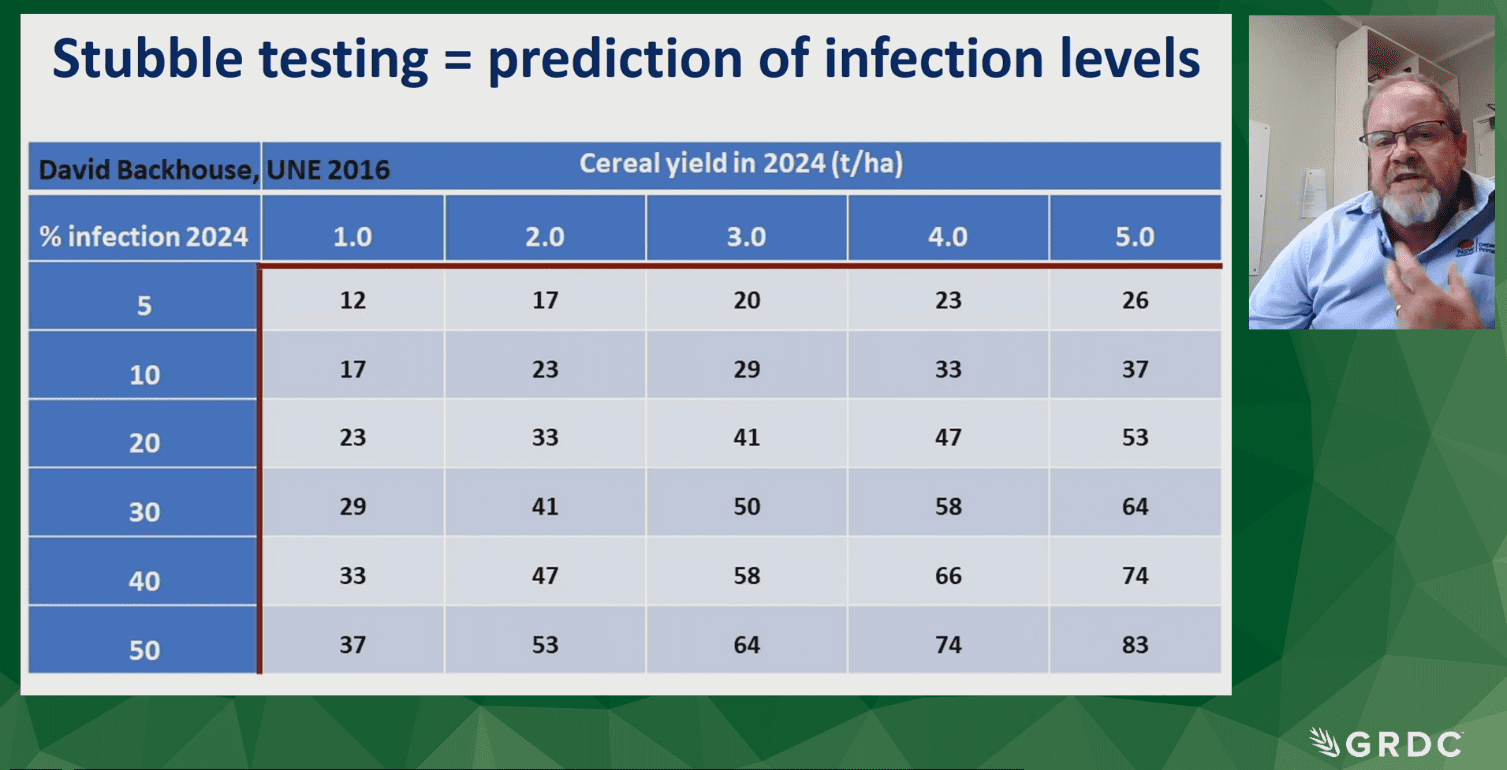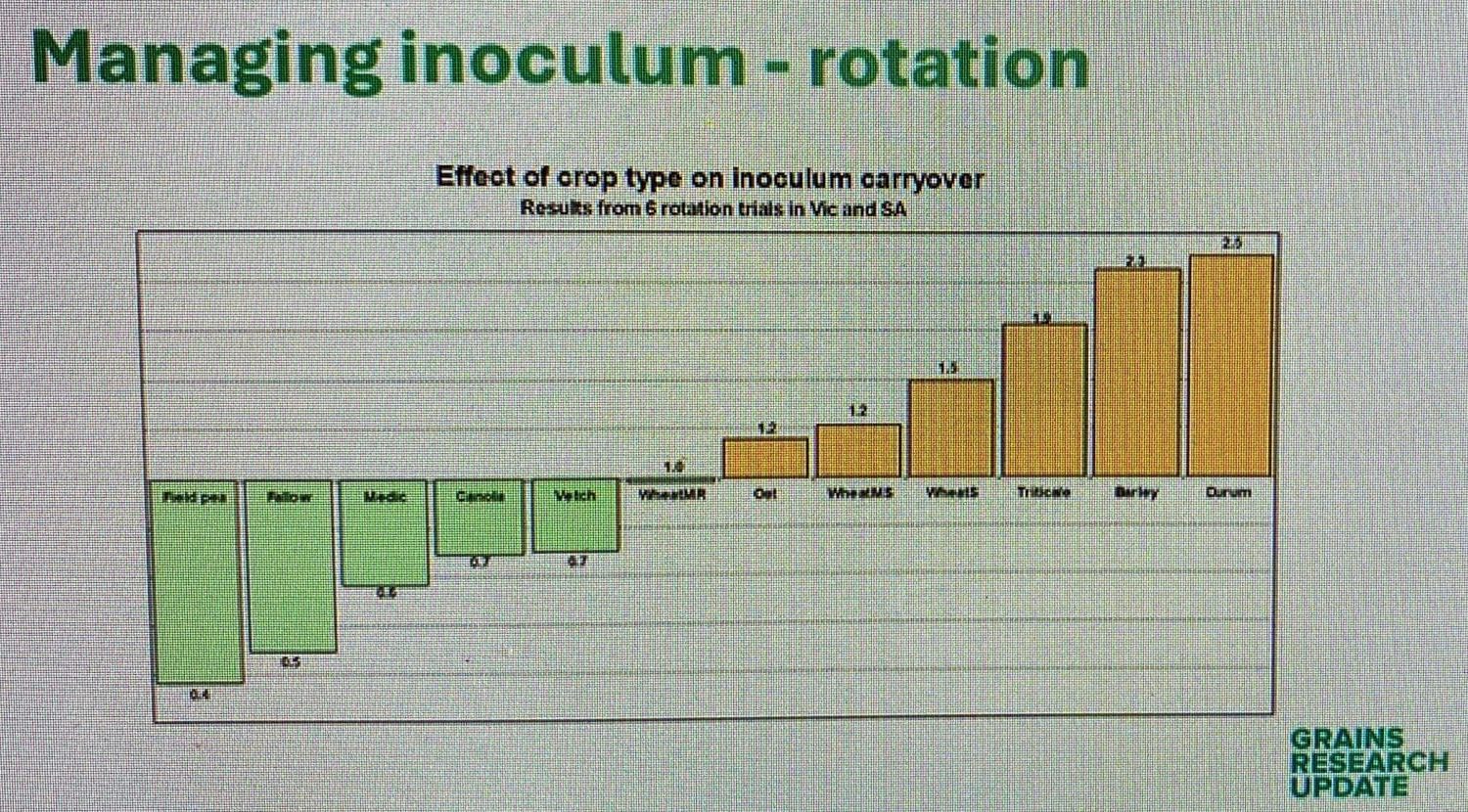
ORM’s Jemma Pearl anchors the GRDC webinar featuring Evans Consulting’s Margaret Evans and NSW DPIRD’s StevenSimpfendorfer.
PLANTING of Australia’s winter cereals is kicking off this month, and growers and advisors keen to hear the latest on how to counter the impact of crown rot in them tuned into a webinar hosted yesterday by ORM on behalf of the Grains Research and Development Corporation.
It featured insights on crown rot from South Australian researcher Margaret Evans of Evans Consulting, and NSW Department of Primary Industries and Regional Development plant pathologist Steven Simpfendorfer.
People from Queensland, NSW, Victoria and South Australia took part in the New opportunities for crown rot management webinar, which also offered insights into the value of the recently approved Syngenta seed treatment, Victrato.
“It’s not a magic bullet, but it does make me want to dance a little happy dance, because it’s the only thing in the 20-odd years that I’ve been working on the problem that really provides something that you can rely on,” Dr Evans said.
Dr Simpfendorfer said he saw it similarly.
“It’s not going to get rid of the problem but it’s certainly a useful addition to the toolbox, but you really do need to test your paddocks and see where you’re going to use it.”
Victrato’s active ingredient, cyclobutrifluram, is a group 7 fungicide.
“There are resistance risks with that that we’re trying to get our head around,” Dr Simpfendorfer said.
“It’s very strong on the fusariums, whether that be crown rot caused by pseudograminearum or culmorum.
“It’s not protecting the heads during flowering; you don’t want a chemical to last that long that’s on the seed.
“The catch with it is because it’s a strong fusarium active, it actually happens to be weak on your bunts and smuts.
“The recommendation is to use Victrato in combination with the lower registered label rate of Vibrance to cover off on your bunts and smuts as well.”
Victrato limits yield losses
Fusarium fungi cause two major diseases in Australia’s winter cereals, crown rot in dry finishes to the growing season, and head blight in wet ones.
Their combined cost to Australian growers from Western Australia to Tasmania and southern Queensland is estimated at $404 million annually, with durum the most susceptible, followed by wheat and then barley.

Dr Evans talks about the prevalence of crown rot in Australia’s major cereal-growing regions.
Dr Evans said Victrato has improved yield and limited inoculum carryover in trials she has been involved in, with the exception of one Eyre Peninsula site in 2023 for Commodus barley, where yield was below that of the control site, in contrast to the other EP site which showed a 7pc increase.
“We believe that it’s mostly about the fact that the barley actually was protected at the start of the season from fast growth of the fungus through the plant, and therefore it grew really, really well and then the end of the season was terrible, and the whole thing fell in a really really big heap”
Dr Evans said a repeat adverse impact from Victrato seemed highly unlikely.
“It really does help in a lot of different ways.”
Dr Simpfendorfer said trials at 25 sites over five seasons in NSW and Qld indicated Victrato gave relatively consistent reductions in extended yield loss.
“In wetter years we get less yield loss from crown rot – 12.7pc yield loss without Victrato, and 2.8pc at 200mm and 1.3pc at 400mm with it.
“When we get dry conditions around the seed, we get more yield loss.”

Table 1: Dr Simpfendorfer oversees a NSW DPIRD stubble-testing program which allows growers to predict the levels of yield loss than can be expected with six infection levels.
In dry seasons, results show an average 33.6pc yield loss without Victrato, reduced to 12.4-17.7pc with it.
“What Victrato does do is reduces severity; it reduces the number of whiteheads, and also reduces the yield loss from crown rot.”
No substitute for planning
Seasons permitting, SA and northern NSW are Australia’s major durum-growing areas, and both Dr Evans and Dr Simpfendorfer stressed the importance of soil testing through PreDicta B tests to determine levels of inoculum prior to planting, even with Victrato available.
With help from GRDC, NSW DPIRD also offers free stubble testing overseen by Dr Simpfendorfer to help guide rotation decisions, which in crown rot-prone paddocks should not include cereal on cereal.
In SA too, Dr Evans said visuals alone cannot indicate an absence of crown rot.
“One of the main things with crown rot is not to forget about it.”
Without testing, Dr Evans said yield losses caused by crown rot can be attributed to stresses such as frost or seasonal conditions.
“Even if you don’t see whiteheads, you can have significant yield loss from crown rot.”
Dr Evans said any sort of moisture stress exacerbated crown rot, and winter cereals including oats can harbour the pathogen in stubble, as can grass weeds including barley grass, ryegrass, and wild oats.
“I think the thing Marg really hit on is…we think of this as a hot dry weather disease; it’s not, it’s there every year,” Dr Simpfendorfer said.
He referenced research by PhD student and AMPS assistant research agronomist Mitch Buster on yield losses to crown rot under well-watered conditions in a glasshouse, because the pathogen was “messing with the base of the plants”.
“In that study, it’s even reducing nitrogen-use efficiency by 14pc…and that comes from basal infections.”
Dr Simpfendorfer said in a wet year, spores splash from lower nodes into the head to cause fusarium head blight, while in a dry year, the pathogen causes crown rot and whiteheads.
He said a 3pc potential yield loss to crown rot might be seen in a kind season, blowing out in the same paddock with the same level of inoculum to 55pc in a season laden with stresses.
“If you get a hot dry finish, we’ve got data that shows even with a three-degree increase in grain-fill temperature, you can go to a 42pc yield loss under those hotter conditions, and only 17pc at the lower temperature.
“The absolute worst-case scenario is 100pc of plants are infected for an 80pc loss in durum returns in hot and dry conditions, 60pc in wheat, and 40pc in barley.”
“If you automatically halve the number of plants that get infected you’re…going to get 40pc, 30pc,20pc losses respectively, so we really need to drive that home.”
Burning, cutlivation no long-term fix
Dr Evans echoed Dr Simpfendorfer’s view that crown rot needed to be managed with careful planning.
“Nearly all of the options that work well are not in crop,” she said, emphasising that rotation crops were a key management tool in minimising the proliferation of crown rot.

Table x: SA trials indicate that durum followed by barley have the greatest impact on building up inoculum levels which will cause crown rot. Source: Evans Consulting
SA trial results indicate growing cereal on cereal can increase inoculum levels by 250pc, whereas a pulse such as field peas can halve it.
“It really doesn’t matter too much what break you choose; you choose the one that does best for you in your system.
“What we learned from this graph is that all of your cereals are actually going to increase inoculum.”
Contrary to what some believe, Dr Evans said burning stubble did not kill the inoculum, as evidenced by the fungus surviving on stubble after a devastating fire at Pinery, north of Adelaide.
“You’ve got the hottest burn you could ever wish to see, and you still didn’t get rid of all the base of the plants.”
Cultivation may disrupt the inoculum, but Dr Evans said its primary effect was to spread the inoculum “all over the place”.
Dr Simpfendorfer has seven management options to consider when sowing cereals in paddocks with a medium to high risk of fusarium crown rot.
- Consider stubble-management options;
- Sow more tolerant wheat or barley varieties, but not durum;
- Sow at the start of the recommended planting window to halve the potential yield loss;
- Consider inter-row sowing, again to halve potential yield loss;
- Do not overdo nitrogen application at sowing, as urea.
“Growing on stored soil moisture, if we put too much N on up front, we can burn our stored moisture, and you’ve got a big canopy you’ve got to support during grain fill, so the saying goes: the bigger they come, the harder they fall.”
“The higher that daily water demand, the more crown rot in the base of those plants becomes an issue in trying to meet that daily demand to fill grain.
“Certainly balance your nitrogen application…particularly up here on heavy clays.”
Dr Simpfendorfer said zinc can extend the time the plant’s vascular system is open in zinc-deficient soils, but it cannot be applied continually.

HAVE YOUR SAY